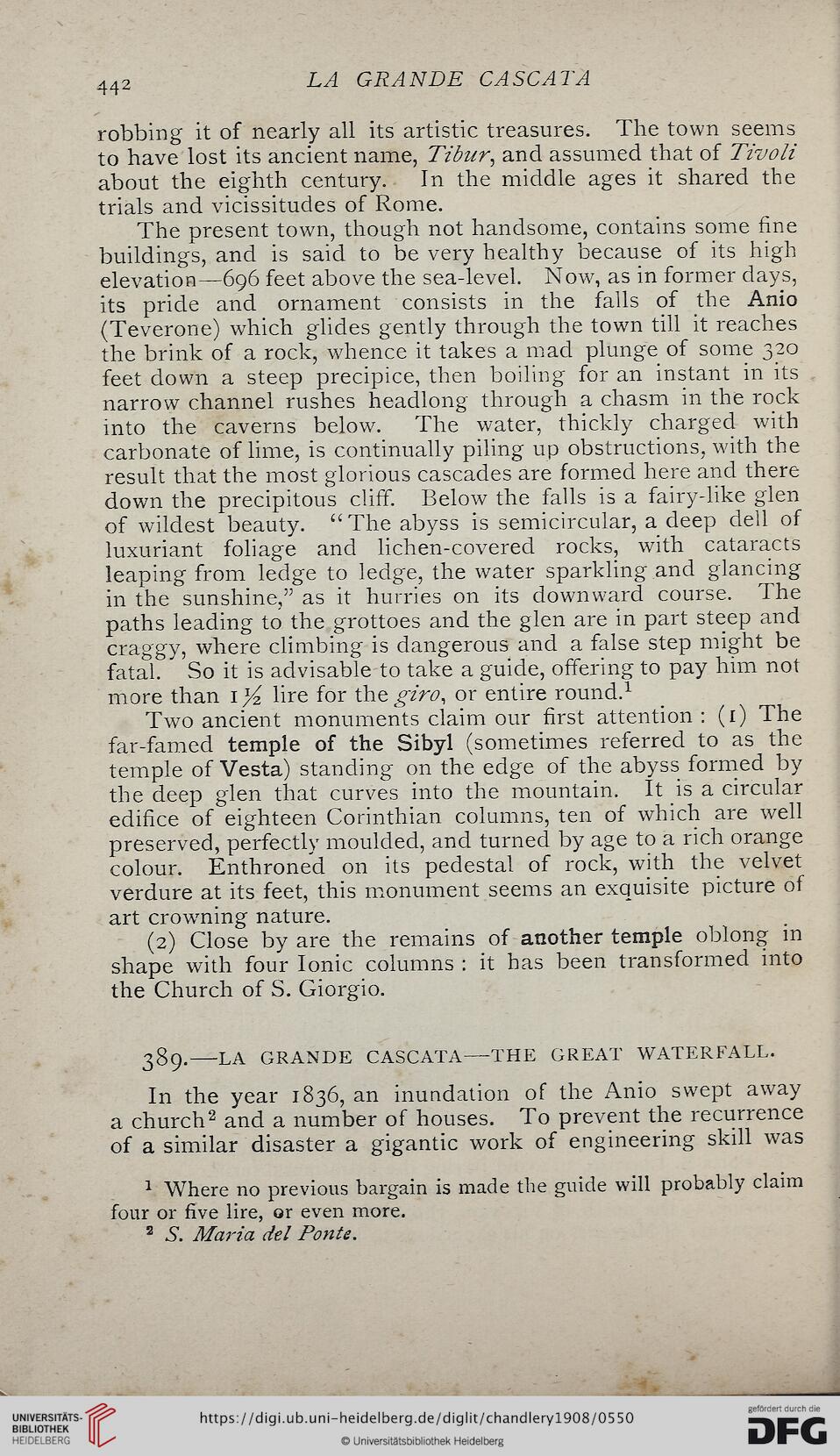442
LA GRANDE C A SC AT A
robbing it of nearly all its artistic treasures. The town seems
to have lost its ancient name, Tibur, and assumed that of Tivoli
about the eighth century. In the middle ages it shared the
trials and vicissitudes of Rome.
The present town, though not handsome, contains some fine
buildings, and is said to be very healthy because of its high
elevation—696 feet above the sea-level. Now, as in former days,
its pride and ornament consists in the falls of the Anio
(Teverone) which glides gently through the town till it reaches
the brink of a rock, whence it takes a mad plunge of some 320
feet down a steep precipice, then boiling for an instant in its
narrow channel rushes headlong through a chasm in the rock
into the caverns below. The water, thickly charged with
carbonate of lime, is continually piling up obstructions, with the
result that the most glorious cascades are formed here and there
down the precipitous cliff. Below the falls is a fairy-like glen
of wildest beauty. “The abyss is semicircular, a deep dell of
luxuriant foliage and lichen-covered rocks, with cataracts
leaping from ledge to ledge, the water sparkling and glancing
in the sunshine,” as it hurries on its downward course. The
paths leading to the grottoes and the glen are in part steep and
craggy, where climbing is dangerous and a false step might be
fatal. So it is advisable to take a guide, offering to pay him not
more than 1% lire for the giro, or entire round.1
Two ancient monuments claim our first attention : (1) The
far-famed temple of the Sibyl (sometimes referred to as the
temple of Vesta) standing on the edge of the abyss formed by
the deep glen that curves into the mountain. It is a circular
edifice of eighteen Corinthian columns, ten of which are well
preserved, perfectly moulded, and turned by age to a rich orange
colour. Enthroned on its pedestal of rock, with the velvet
verdure at its feet, this monument seems an exquisite picture of
art crowming nature.
(2) Close by are the remains of another temple oblong in
shape with four Ionic columns : it has been transformed into
the Church of S. Giorgio.
389.-LA GRANDE CASCATA—THE GREAT WATERFALL.
In the year 1836, an inundation of the Anio swept away
a church2 and a number of houses. To prevent the recurrence
of a similar disaster a gigantic work of engineering skill was
1 Where no previous bargain is made the guide will probably claim
four or five lire, or even more.
2 .S’. Maria del Ponte.
LA GRANDE C A SC AT A
robbing it of nearly all its artistic treasures. The town seems
to have lost its ancient name, Tibur, and assumed that of Tivoli
about the eighth century. In the middle ages it shared the
trials and vicissitudes of Rome.
The present town, though not handsome, contains some fine
buildings, and is said to be very healthy because of its high
elevation—696 feet above the sea-level. Now, as in former days,
its pride and ornament consists in the falls of the Anio
(Teverone) which glides gently through the town till it reaches
the brink of a rock, whence it takes a mad plunge of some 320
feet down a steep precipice, then boiling for an instant in its
narrow channel rushes headlong through a chasm in the rock
into the caverns below. The water, thickly charged with
carbonate of lime, is continually piling up obstructions, with the
result that the most glorious cascades are formed here and there
down the precipitous cliff. Below the falls is a fairy-like glen
of wildest beauty. “The abyss is semicircular, a deep dell of
luxuriant foliage and lichen-covered rocks, with cataracts
leaping from ledge to ledge, the water sparkling and glancing
in the sunshine,” as it hurries on its downward course. The
paths leading to the grottoes and the glen are in part steep and
craggy, where climbing is dangerous and a false step might be
fatal. So it is advisable to take a guide, offering to pay him not
more than 1% lire for the giro, or entire round.1
Two ancient monuments claim our first attention : (1) The
far-famed temple of the Sibyl (sometimes referred to as the
temple of Vesta) standing on the edge of the abyss formed by
the deep glen that curves into the mountain. It is a circular
edifice of eighteen Corinthian columns, ten of which are well
preserved, perfectly moulded, and turned by age to a rich orange
colour. Enthroned on its pedestal of rock, with the velvet
verdure at its feet, this monument seems an exquisite picture of
art crowming nature.
(2) Close by are the remains of another temple oblong in
shape with four Ionic columns : it has been transformed into
the Church of S. Giorgio.
389.-LA GRANDE CASCATA—THE GREAT WATERFALL.
In the year 1836, an inundation of the Anio swept away
a church2 and a number of houses. To prevent the recurrence
of a similar disaster a gigantic work of engineering skill was
1 Where no previous bargain is made the guide will probably claim
four or five lire, or even more.
2 .S’. Maria del Ponte.




